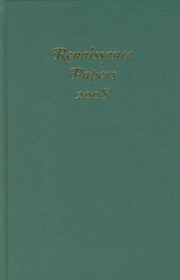Book contents
- Frontmatter
- Contents
- Renaissance Papers
- Cardinal Wolsey: The English Cardinal Italianate
- Pope Gregory and the Gens Anglorum: Thomas Stapleton's Translation of Bede
- The Spenserian Paradox of Intended Response
- Lucan, Marlowe, and the Poetics of Violence
- Hell Is Discovered
- Private and Public Plays in the Private Theaters: Speculation on the Mercenary Methods of Second Paul's and Second Blackfriars
- Staging Dismemberment in Early Modern Drama: Playing Mnemonics and Meaning
- Serving Theater in Volpone
- Troilus and Cressida: An Epitaph for the History Play
- “What thing thou art, thus double-formed”: Naming, Knowledge, and Materialism in Paradise Lost
Cardinal Wolsey: The English Cardinal Italianate
Published online by Cambridge University Press: 12 September 2012
- Frontmatter
- Contents
- Renaissance Papers
- Cardinal Wolsey: The English Cardinal Italianate
- Pope Gregory and the Gens Anglorum: Thomas Stapleton's Translation of Bede
- The Spenserian Paradox of Intended Response
- Lucan, Marlowe, and the Poetics of Violence
- Hell Is Discovered
- Private and Public Plays in the Private Theaters: Speculation on the Mercenary Methods of Second Paul's and Second Blackfriars
- Staging Dismemberment in Early Modern Drama: Playing Mnemonics and Meaning
- Serving Theater in Volpone
- Troilus and Cressida: An Epitaph for the History Play
- “What thing thou art, thus double-formed”: Naming, Knowledge, and Materialism in Paradise Lost
Summary
IN September of 1515, Thomas Wolsey, Archbishop of York, received a cardinal's hat from the Pope; on Christmas Eve of the same year, he attained the chain of office of Lord Chancellor of England from King Henry VIII. Compounding the cardinal's hat with the chain of Lord Chancellor unleashed Wolsey's unbridled passion. For the next fourteen years, he would be the most powerful man in England except, possibly, for the king. As his power increased, so did his interest in displaying it. Using the generous income from his ecclesiastical benefices, Wolsey embarked upon a building campaign whose scale was unprecedented for an English churchman and Lord Chancellor. Few English kings had built on such a scale. How could Wolsey justify his grandiose behavior? The answer lies in the web of court decorum and the source of his models. As this paper will demonstrate, Wolsey, as a prince of the church, looked beyond the shores of England to Rome, where he found the building programs of Italian cardinals from high ranking families with close ties to the papal throne to set an appropriate benchmark for his own display of rank and position. Wolsey's behavior, his decorum, his vision of the display of power in the present and in perpetuity, and his buildings— including their location, layout, furnishings, embellishments, ceremonial function, and the theory that drove them—drew heavily on Italian models.
- Type
- Chapter
- Information
- Renaissance Papers 2008 , pp. 1 - 14Publisher: Boydell & BrewerPrint publication year: 2009



